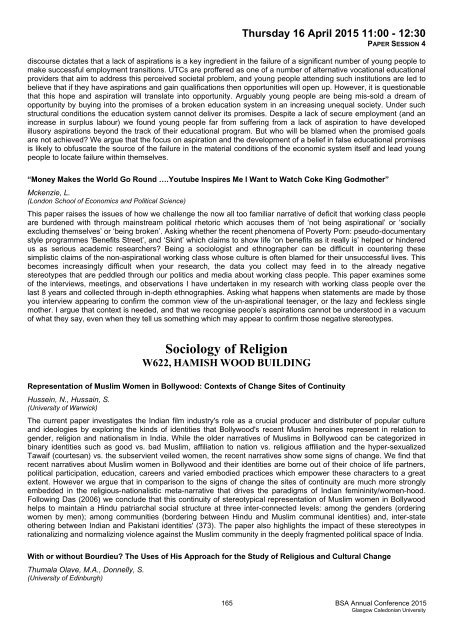Programme full
Programme full
Programme full
Create successful ePaper yourself
Turn your PDF publications into a flip-book with our unique Google optimized e-Paper software.
Thursday 16 April 2015 11:00 - 12:30<br />
PAPER SESSION 4<br />
discourse dictates that a lack of aspirations is a key ingredient in the failure of a significant number of young people to<br />
make successful employment transitions. UTCs are proffered as one of a number of alternative vocational educational<br />
providers that aim to address this perceived societal problem, and young people attending such institutions are led to<br />
believe that if they have aspirations and gain qualifications then opportunities will open up. However, it is questionable<br />
that this hope and aspiration will translate into opportunity. Arguably young people are being mis-sold a dream of<br />
opportunity by buying into the promises of a broken education system in an increasing unequal society. Under such<br />
structural conditions the education system cannot deliver its promises. Despite a lack of secure employment (and an<br />
increase in surplus labour) we found young people far from suffering from a lack of aspiration to have developed<br />
illusory aspirations beyond the track of their educational program. But who will be blamed when the promised goals<br />
are not achieved? We argue that the focus on aspiration and the development of a belief in false educational promises<br />
is likely to obfuscate the source of the failure in the material conditions of the economic system itself and lead young<br />
people to locate failure within themselves.<br />
“Money Makes the World Go Round ….Youtube Inspires Me I Want to Watch Coke King Godmother”<br />
Mckenzie, L.<br />
(London School of Economics and Political Science)<br />
This paper raises the issues of how we challenge the now all too familiar narrative of deficit that working class people<br />
are burdened with through mainstream political rhetoric which accuses them of ‘not being aspirational’ or ‘socially<br />
excluding themselves’ or ‘being broken’. Asking whether the recent phenomena of Poverty Porn: pseudo-documentary<br />
style programmes ‘Benefits Street’, and ‘Skint’ which claims to show life ‘on benefits as it really is’ helped or hindered<br />
us as serious academic researchers? Being a sociologist and ethnographer can be difficult in countering these<br />
simplistic claims of the non-aspirational working class whose culture is often blamed for their unsuccessful lives. This<br />
becomes increasingly difficult when your research, the data you collect may feed in to the already negative<br />
stereotypes that are peddled through our politics and media about working class people. This paper examines some<br />
of the interviews, meetings, and observations I have undertaken in my research with working class people over the<br />
last 8 years and collected through in-depth ethnographies. Asking what happens when statements are made by those<br />
you interview appearing to confirm the common view of the un-aspirational teenager, or the lazy and feckless single<br />
mother. I argue that context is needed, and that we recognise people’s aspirations cannot be understood in a vacuum<br />
of what they say, even when they tell us something which may appear to confirm those negative stereotypes.<br />
Sociology of Religion<br />
W622, HAMISH WOOD BUILDING<br />
Representation of Muslim Women in Bollywood: Contexts of Change Sites of Continuity<br />
Hussein, N., Hussain, S.<br />
(University of Warwick)<br />
The current paper investigates the Indian film industry's role as a crucial producer and distributer of popular culture<br />
and ideologies by exploring the kinds of identities that Bollywood's recent Muslim heroines represent in relation to<br />
gender, religion and nationalism in India. While the older narratives of Muslims in Bollywood can be categorized in<br />
binary identities such as good vs. bad Muslim, affiliation to nation vs. religious affiliation and the hyper-sexualized<br />
Tawaif (courtesan) vs. the subservient veiled women, the recent narratives show some signs of change. We find that<br />
recent narratives about Muslim women in Bollywood and their identities are borne out of their choice of life partners,<br />
political participation, education, careers and varied embodied practices which empower these characters to a great<br />
extent. However we argue that in comparison to the signs of change the sites of continuity are much more strongly<br />
embedded in the religious-nationalistic meta-narrative that drives the paradigms of Indian femininity/women-hood.<br />
Following Das (2006) we conclude that this continuity of stereotypical representation of Muslim women in Bollywood<br />
helps to maintain a Hindu patriarchal social structure at three inter-connected levels: among the genders (ordering<br />
women by men); among communities (bordering between Hindu and Muslim communal identities) and, inter-state<br />
othering between Indian and Pakistani identities' (373). The paper also highlights the impact of these stereotypes in<br />
rationalizing and normalizing violence against the Muslim community in the deeply fragmented political space of India.<br />
With or without Bourdieu? The Uses of His Approach for the Study of Religious and Cultural Change<br />
Thumala Olave, M.A., Donnelly, S.<br />
(University of Edinburgh)<br />
165 BSA Annual Conference 2015<br />
Glasgow Caledonian University


